bread without yeast, homemade

Yesterday I had published another good recipe for making homemade plain bread without yeast. Today I am continuing with this theme of plain bread without yeast. I do hope that you do enjoy making this type of bread and there will several more recipes with the theme plain bread without yeast in the articles to come. This recipe for making plain bread without yeast turned out to be very tender .
Tender homemade plain bread without yeast
If you had read my earlier article you would realise that my success was no accident and I had failed many times. This time around I have managed to make the bread very tender. It was so tender that many thought that it was almost like cake. Please refer to my previous article on plain bread without yeast to see the difference in recipes.
This time around I used baking powder as the raising agent. Unlike baking soda which can make the bread taste awful and the colour slightly greenish if you use too much, baking powder has a more neutral flavour and does not discolour the bread. There is one difficulty with baking powder and that is it will release gases if exposed to water or other liquids. Since its rising actions begins in the presence of water, it is very important to quickly transfer the mixed dough into a baking tray before a lot of the gases escape.
The homemade plain bread without yeast recipe
| Plain Bread without Yeast | ||||
| Item | Ingredients | Percentage | Weight | Weight |
| (%) | (g) | oz. | ||
| 1 | Self raising flour | 100 | 200.00 | 7.04 |
| 2 | Bread Flour | 100 | 200.00 | 7.04 |
| Flour subtotal | 200 | 400.00 | 14.08 | |
| 3 | Sugar | 3 | 12.00 | 0.42 |
| 4 | Salt | 0.667 | 2.67 | 0.09 |
| 5 | Butter | 9 | 36.00 | 1.27 |
| 6 | Baking Powder | 2 | 8.00 | 0.28 |
| 7 | Water | 65 | 260.00 | 9.15 |
Photos of the homemade plain bread process
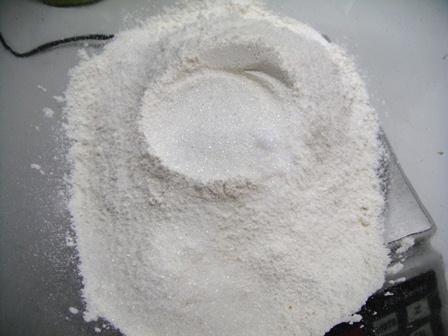
Weigh all the ingredients, for the plain bread recipe, into a bowl but hold back on the butter and the water. Mix the dry ingredients first before adding the butter, sugar and baking powder. This will ensure that the ingredients are uniformly distributed before butter is added.
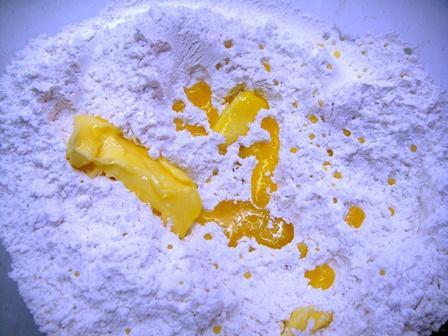
Add the butter and use you fingers and gently rub the butter into the flour. Rub it into fine lumps. The lumps will melt and leave small holes in the bread when baked. These holes will make it look more like bread than cake. Furthermore, the butter and sugar in the recipe adds flavour.
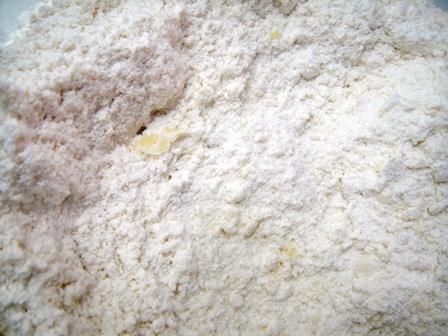
This is how it will look when the butter is rubbed into the flour with your fingers.
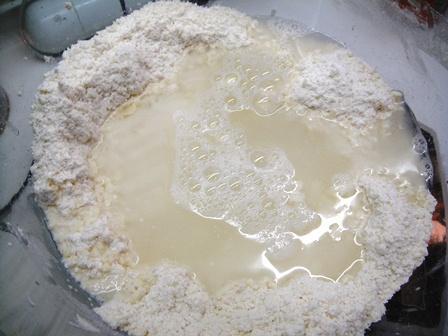
Then pour in the water in one go. I may have made an error in the previous article, it looks like self-raising flour can hold more water than bread flour. I am using 65% water with respect to the weight of the flour. If I had tried to use more water it would become batter. Please refer to my previous article on how to choose your flour.

This time around I am not using my hands to very gently stir the flour water mixture. If you are to vigorous or rough, a lot of gluten will be released and the bread will become tough. You can see from the picture that there are lots of air pockets in the dough. This is because baking powder has a double action. Firstly, in the presence of water or other water based liquids such as milk, yogurt or eggs, it will releases gases. Secondly, as the the temperature rises, during baking, it will release gases. This is the tricky part of using baking powder. The dough should not be too wet, not almost like batter, that the gases released in the presence of water bubble to the surface and escape. Too much vigorous stirring can expose all the trapped gases and allow them to escape. One of the general differences between bread and cake is that bread dough is allowed to rise before baking.

Quickly rub the some cooking oil along the sides of the tin. Actually, if I had done this step earlier, now I would not be in so much of a rush.
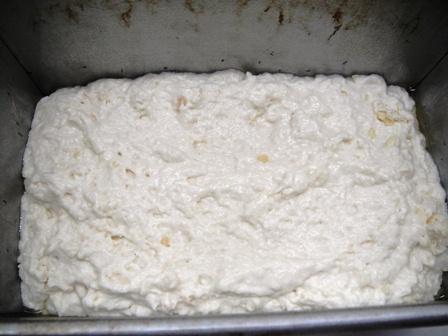
I quickly transferred the dough into a bread baking tin and then used an oiled spoon to flatten or rather level the top of the dough. The oiled spoon gave the top of the dough a nice shine.
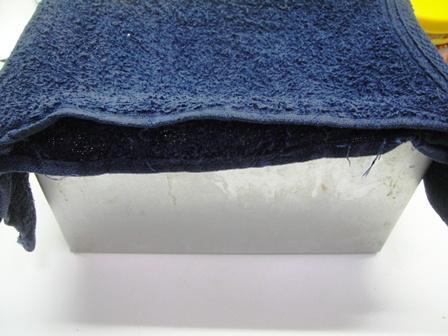
Then cover the dough with a really damp cloth and let it rest for half an hour. The resting is to ensure the bread dough relaxes enough to lose its elasticity and become pliable. This will allow the rising gases, during baking, to push and expand the dough. The damp cloth is to prevent the dough from drying out and forming a tough skin on the outside. Read my article on making rock bread without yeast. You will realise that the article was written in jest to show all the wrong ways to make bread without yeast. If the dough forms a thick skin as it dries the baked crust will be very hard.
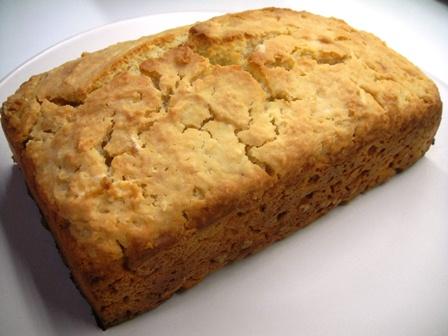
I baked it for 40 minutes at 220C (428F) but for this particular recipe it would have been better if it was baked for 45 to 50 minutes. The homemade plain bread without yeast looks really nice and the crust was thin crust.
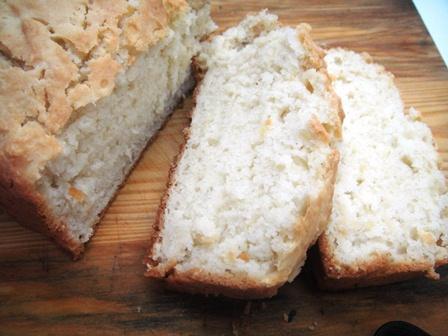
This homemade plain bread was really tender and good to taste. I will try to improve on this homemade plain bread recipe. Learn more about homemade plain bread without yeast by learning about the history of bread.

The best way to eat this homemade plain bread without yeast is with lots of butter.
How to make bread without yeast and the Batter & Dough Method
9.How to make garlic bread the batter and dough method
8.how to make bread the batter and dough method
7.How to make bread with self raising or self rising flour a new method
6.How to make plain simple bread a new method
5.how to make plain bread without yeast part 4
4.how to make plain bread without yeast part 3
3.how to make plain bread without yeast part 2
2.How to make plain bread without yeast
1.How to make rock bread without yeast
Please do click on the facebook and Google+ like buttons if you found this article informative and useful.
This article on How to make plain bread without yeast was researched and written by Peter Achutha
Leave a Reply